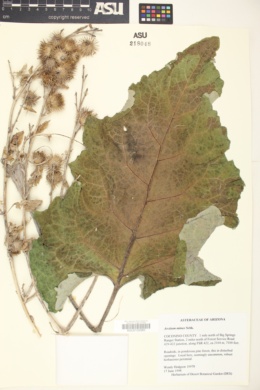|
|
|
|
Family: Asteraceae
lesser burdock, more...bardane, beggar's button, burdock, common burdock, lesser burrdock, small burdock, smaller burdock, wild burdock, wild rhubarb
[Lappa minor Hill] |
Plants to 50-300 cm. Basal leaves: petioles hollow (sometimes only at base), 15-50 cm, thinly to densely cobwebby; blades 30-60 × 15-35 cm, coarsely dentate to subentire (rarely deeply dissected), abaxially ± thinly gray-tomentose, adaxially green, sparsely short-hairy. Heads in racemiform or paniculiform clusters, sessile to pedunculate. Peduncles 0-9.5 cm. Involucres 15-40 mm diam. Phyllaries linear to linear-lanceolate, glabrous to densely cobwebby, inner often purplish tinged, margins often minutely serrate with fine teeth, puberulent with glandular and or eglandular hairs. Florets 30+; corollas purple, pink, or white, 7.5-12 mm, glabrous or limb glandular-puberulent. Cypselae dark brown or with darker spots, 5-8 mm; pappus bristles 1-3.5 mm. 2n = 32 (Germany), 36 (as A. nemorosum). Flowering summer-early fall (Jul-Sep). Waste places, roadsides, fields, forest clearings; 0-2200 m; introduced; St. Pierre and Miquelon; Alta., B.C., Man., N.B., Nfld. and Labr. (Nfld.), N.S, Ont., P.E.I, Que., Sask.; Ala., Ariz., Ark., Calif., Colo., Conn., Del., D.C., Ga., Idaho, Ill., Ind., Iowa, Kans., Ky., Maine, Md., Mass., Mich., Minn., Miss., Mo., Mont., Nebr., Nev., N.H., N.J., N.Mex., N.Y., N.C., N.Dak., Ohio, Okla., Oreg., Pa., R.I., S.C., S.Dak., Tenn., Tex., Utah, Vt., Va., Wash., W.Va., Wis., Wyo.; Eurasia. Arctium minus has been reported from Delaware and Texas; I have not seen specimens. Arctium minus is a complex species with many variants that have been recognized at ranks ranging from forma to species (J. Arènes 1950). Some North American workers (e.g., R. J. Moore and C. Frankton 1974) have often distinguished plants with involucres more than 3 cm diameter that equal or overtop the corollas as A. nemorosum. Arènes treated those plants as a subspecies of A. minus. Arctium nemorosum was recognized as a species distinct from A. minus (H. Duistermaat 1996), with a different and more restricted circumscription than that used by North American workers. Although most of the characters that Duistermaat used to separate those A. nemorosum from A. minus overlap extensively, the consistently wider mid phyllaries of A. nemorosum (1.7-2.5 mm wide versus 0.6-1.6 mm in A. minus) supposedly distinguish the species. None of the North American specimens examined in preparation of this treatment had the wide phyllaries of A. nemorosum in the sense of Duistermaat, who stated that she had seen no material of this taxon from the American continent. Some American authors have taken up the name Arctium vulgare in place of A. nemorosum and applied A. vulgare (dubbed woodland burdock) to the larger-headed North American plants. Duistermaat considers A. vulgare to be a synonym of A. lappa.
Plant: plant < 15 dm, biennial; stem: branches stiffly ascending Leaves: basal and cauline, alternate, long-petioled, widely ovate; base deeply cordate; blade < 40+ cm, green, puberulent or soft-hairy above, becoming glabrous, ± gray-tomentose below INFLORESCENCE: heads sessile to short-peduncled in raceme- or panicle-like clusters; involucre 10-25 mm diam; inner phyllaries generally purple-tinged, margins minutely serrate Flowers: many; corolla pink to ± purple, 8-10 mm, lobes narrowly triangular; anther base tailed, tips ovate, acute to obtuse; style branched just above hairy ring, branches oblong, obtuse Fruit: achene, 4-7.5 mm, dark brown or dark-spotted, compressed, rough or ribbed, glabrous, attachment basal; pappus several series of rough bristles, readily deciduous, ± 2 mm Misc: Disturbed places; < 1200 m. |

























































































